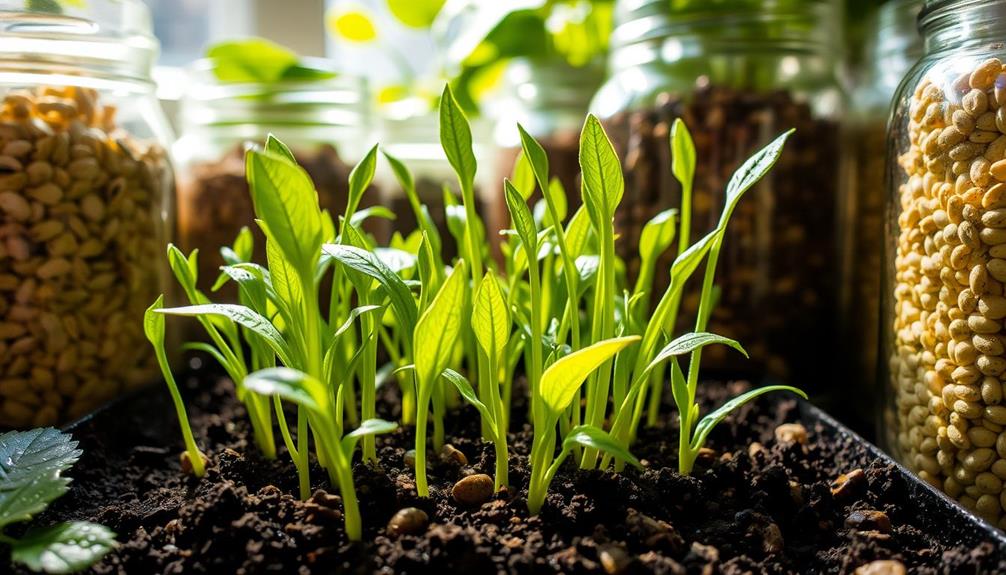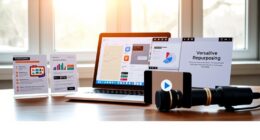Raw food refers to uncooked and unprocessed ingredients, typically not heated over 115°F (46°C). You'll find a variety of fresh fruits, vegetables, nuts, seeds, and sprouted grains as staples. This approach preserves essential nutrients and enzymes that cooking can destroy, enhancing your health benefits. High water content in raw foods also helps keep you hydrated. To enjoy a raw diet, you can juice, blend, soak, or even dehydrate your ingredients. If you're curious about how to shift smoothly to this lifestyle or want tips on preparing delicious raw meals, you're in for some enlightening insights ahead.
Key Takeaways
- Raw food consists of uncooked and unprocessed foods, not heated above 115°F (46°C), preserving essential nutrients and enzymes.
- Common raw foods include fresh fruits, vegetables, nuts, seeds, and sprouted grains, emphasizing organic options for greater nutrient retention.
- A raw diet enhances nutrient intake, promotes weight loss through high fiber, and lowers the risk of chronic diseases.
- Sprouting techniques, such as soaking seeds for 8-12 hours, boost nutrition and flavor in raw meals.
- Transitioning to a raw diet can be eased by starting with breakfast smoothies and gradually incorporating more raw foods into meals.
What Is Raw Food?
Raw food, often praised for its health benefits, refers to uncooked and unprocessed foods that aren't heated above 115°F (46°C). This diet primarily includes fresh fruits, vegetables, nuts, seeds, and sprouted grains, emphasizing their natural state. By consuming raw food, you preserve essential enzymes and nutrients that cooking can destroy, which many advocates argue diminishes the food's nutritional value.
Additionally, raw foods are known to boost immune system function due to their high vitamin and antioxidant levels, and they promote weight loss through low-calorie, high-fiber foods benefits of raw food.
When you focus on a raw food diet, you'll notice that these foods typically contain high water content, with fruits and vegetables comprising about 70-90% water. This helps support hydration and overall wellness.
Preparation methods for raw food can vary, allowing for creativity and variety in your meals. Techniques like juicing, blending, dehydrating, soaking, and sprouting keep the food's natural properties intact while offering different textures and flavors.
Benefits of a Raw Diet

When you choose a raw food diet, you'll likely experience a wealth of health benefits that stem from consuming nutrient-dense, unprocessed foods. By focusing on raw fruits and vegetables, you increase your nutrient content greatly, helping to lower your risks of chronic diseases and achieve improved overall health.
The high fiber found in raw foods promotes better digestion and supports weight loss due to their lower calorie density. Additionally, raw foods are typically rich in antioxidants, which can further enhance your overall health and wellness, much like the benefits associated with cranberry juice consumption.
One of the standout benefits of a raw food diet is the retention of enzymes in the food. These essential enzymes and vitamins are often destroyed during cooking, meaning you can enjoy enhanced nutritional benefits. Many people following this diet report increased energy levels and improved mental clarity, which can be attributed to the abundance of nutrients in their meals.
Additionally, studies suggest that a raw food diet can lead to lower cholesterol levels and improved metabolic health. Embracing a plant-based diet filled with fresh, uncooked produce may help you align with the goal of reducing processed food intake while reaping the numerous benefits that come along with it.
Key Ingredients to Include

Incorporating the right ingredients is crucial for maximizing the benefits of a raw food diet. Start with fresh fruits and vegetables, as they're the cornerstone of your meals, providing important nutrients and hydration with their high water content. Aim for organic options whenever possible to guarantee you're getting the most from your produce.
Additionally, consider the impact of diet on overall health, as the right foods can influence your well-being.
Don't overlook raw nuts and seeds; they're packed with healthy fats, protein, and fiber, making them a perfect energy source. You can also include sprouted grains and legumes, like sprouted beans and quinoa, which enhance both flavor and nutrition in your dishes.
Young sprouts, especially alfalfa sprouts, are incredibly nutrient-dense, offering a wealth of vitamins and a surprising 35% protein content.
To elevate your meals, incorporate raw oils, vinegars, and herbs. These ingredients not only enhance taste but also help retain nutritional integrity, making them crucial in your raw food preparations.
Sprouting Techniques

Sprouting is a fantastic way to boost the nutritional value of your meals, and it's surprisingly easy to do at home. By soaking seeds, grains, or legumes in water for 8-12 hours, you're kickstarting the germination process, which enhances their nutrition and flavor. After soaking, rinse and drain them to promote healthy growth.
Here's a quick overview of some commonly sprouted foods:
| Food Type | Nutrient Density |
|---|---|
| Alfalfa | High in vitamins |
| Mung Beans | Rich in protein |
| Lentils | Packed with fiber |
| Chickpeas | Great for minerals |
| Quinoa | Complete protein |
To guarantee successful sprouting, use clean containers designed for soaking and draining. The ideal temperature for sprouting is between 70°F and 75°F, with good air circulation to prevent mold. Remember to rinse the seeds 2-3 times daily to keep them moist, which is essential for achieving the best nutrition. Sprouted foods can easily be added to salads, wraps, and smoothies, providing you with a delicious boost of health benefits!
Tips for Transitioning

Shifting to a raw food diet can be a rewarding experience, and starting with just a few simple changes can make all the difference. Begin your progression by incorporating raw breakfast options like smoothies or fruit salads. Gradually increase your raw food intake at each meal to ease into the diet.
Including essential oils for hair growth can also complement your dietary changes by promoting healthy hair as you embrace a vibrant lifestyle.
To make your raw meals more enticing, experiment with marinated vegetables and create delicious raw dips and sauces. Utilizing a variety of fresh, ripe organic produce is key to ensuring a balanced nutrient intake while maximizing taste.
You can also adapt your favorite cooked recipes into raw versions—consider using techniques like dehydrating or blending to achieve new textures and flavors.
Don't forget the power of community! Join online groups or local gatherings focused on raw food. Sharing experiences, recipes, and tips with like-minded individuals can provide motivation and support during your progression.
Frequently Asked Questions
What Is Raw Food Explanation?
Raw food consists of unprocessed plant or animal products, kept below 115°F. You'll enjoy fresh fruits, vegetables, nuts, and seeds, believing they preserve essential nutrients and enzymes that support your health and digestion.
What Is the Raw Food Diet Full Explanation?
The raw food diet emphasizes uncooked, unprocessed foods, aiming to preserve nutrients and enzymes. You might explore various interpretations, balancing nutrients while enjoying fruits, vegetables, nuts, and seeds, with careful planning to avoid deficiencies. Proponents of the raw food diet believe that cooking can destroy important vitamins and enzymes, so adherents focus on eating foods in their natural state. However, it’s important to note that some foods, like meats and eggs, can pose health risks if not properly prepared. To ensure safety and the best nutritional value, it’s important to follow proper raw food storage tips to minimize the risk of contamination and spoilage.
What Are Raw Food Principles?
So, you think cooking's overrated? Embrace raw food principles! You'll munch on fresh fruits, veggies, and nuts, avoiding heat to preserve nutrients. It's all about maximizing those enzymes for your health—who needs a stove anyway?
What Are Examples of Raw Foods?
You'll find examples of raw foods in fresh fruits like apples and berries, crunchy vegetables such as carrots and cucumbers, nutritious nuts like almonds, and sprouted grains. These foods pack essential nutrients without cooking.
Conclusion
Embracing a raw food lifestyle can be a rejuvenating journey that revitalizes your body and spirit. By incorporating vibrant, unprocessed ingredients, you'll discover a world of flavors that dance on your palate. While shifting might feel like stepping into uncharted territory, each small change brings you closer to a nourishing haven. So, don't shy away from this delightful adventure; let your culinary creativity flourish and enjoy the countless benefits that come with savoring nature's bounty in its purest form.










